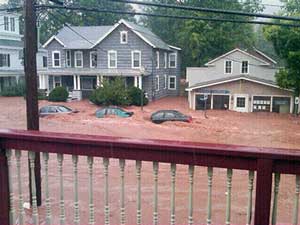New York’s Catskills
Residents struggle to survive Hurricane Irene
Published Sep 11, 2011 9:38 PM
By René Imperato & Stephanie Hedgecoke
Woodstock, N.Y.
It may not be apparent to those just happy that the winds have died down, but
for thousands whose homes and lives were damaged and destroyed in epic flooding
following Hurricane Irene’s arrival, the storm’s aftermath is a
prolonged struggle to survive. The initial disaster downed tens of thousands of
power lines and trees throughout a huge area inland of the Atlantic Coast, from
South Carolina to upstate New York to Vermont.
|
Flooding continued for days after the storm
in New York.
|
Here in New York state’s Hudson Valley, you can see the results.
Volunteers gathered donations of supplies on Sept. 4, one week after the storm.
They took them from the damaged towns of Woodstock and Ellenville to the
ravaged towns of Phoenicia, Fleishmanns and Margaretville, and to some others
like Prattsville, which was totally devastated.
It took workers two days to clear fallen trees that blocked large portions of
the New York Thruway. Fallen trees and power lines plus flood waters closed
smaller roadways all over the region. Roads were even washed out.
Millions lost power for days and many of them still have no power as of Sept.
6. In New York state alone, 600 roads and 22 state bridges were wiped out, and
uncounted other county, town and private bridges washed away.
As county and town workers began to explore the damage, a town cop in Windham
was widely quoted as saying that “Prattsville is toast.” Everything
in Prattsville was destroyed. After the storm, only the ruins of four buildings
remained.
Hundreds of utility workers from Florida, Topeka, Kan., Tulsa, Okla., and
places in between traveled to the affected areas to put in 12- to 14-hour days
clearing the devastation and restoring power. People are waiting for their
areas to be cleared and power restored, as well as for water to drink and wash
with while their food rots.
New York state issued some 78 boil-water orders in areas where the safety of
drinking water was compromised by sewage runoff. Hundreds remain altogether
displaced after their homes were knocked off foundations and washed away, or
were inundated and remain loaded with water and mud, creating further disaster
as mold sets in.
Local volunteers are working through firehouses, churches and community groups
to centralize and distribute aid. While the official emphasis has been on
restoring the infrastructure, if and when local communities receive any
assistance to restore or rebuild varies from place to place.
The many local small farmers in this region also suffered overwhelming losses
of their crops. Many will never recover without assistance to rebuild and to
restore the lands. Some even lost all their topsoil to storm-related erosion.
All along the Wallkill River, farmlands are under water.
Driving north on Route 28, a caravan from Woodstock witnessed the damage to the
road and local bridges, and the swaths along a reservoir and the Esopus Creek
where flooding had washed out homes and infrastructure. The Esopus alone rose
23 feet above its usual 3-foot depth, surpassing its historic floodplains.
These writers saw huge yellow New York State Department of Transportation
trucks hauling away load after load of debris from destroyed housing.
Fleischmanns Community Church has been converted to a full-time emergency soup
kitchen and resource center for those who have lost much or all. Staffers there
detailed the known scope of the displaced population and directed the unloading
of truckloads of supplies.
While most scientists shy off from suggesting a direct connection between
global warming and any specific storm, most of them do state that climate
change means more and worse storms. Yet one Tea Partyer in the U.S. House of
Representatives, Nan Hayworth (R-Mount Kisco, N.Y.), spent the weekend not
helping local people who lost power, food and homes, but rather defending her
position that the federal government should cut more social services in
exchange for the FEMA monies spent on this huge disaster. Tea Partyers in the
House intend to add to the suffering by blocking new funds for FEMA. Their
plots to further wound the thousands of suffering are a crime against the
people.
Anger is rising in the wake of the floodwaters. Reports have come out of
Phoenicia of violence sparked by the limited daily water distribution of two
pints per person.
A worker in the Catskills who emigrated from Poland years ago said, “This
would never happen in Poland.” He went on to state, “The press told
us the streets were paved with gold in America, but all we found were
potholes!”
Money for jobs, infrastructure and disaster relief, not for a new oil war in
Libya!
Articles copyright 1995-2012 Workers World.
Verbatim copying and distribution of this entire article is permitted in any medium without royalty provided this notice is preserved.
Workers World, 55 W. 17 St., NY, NY 10011
Email:
[email protected]
Subscribe
[email protected]
Support independent news
DONATE


